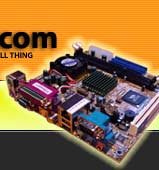|  | September 05, 2017
Choosing the right DC-DC PSU August 27, 2015
AMD's Project Quantum August 13, 2015
The Redstone PC is the ultimate Mini-ITX Minecraft Machine October 09, 2014
The "Restomod TV" April 09, 2013
Installing NAS4Free February 28, 2013
Building an XBMC 12 Home Theatre PC January 25, 2011
XBMC Guide updated to version 10.0 August 06, 2010
Building a Green PC February 15, 2010
Building an ION powered HTPC with XBMC October 10, 2008
The "Cambridge Autonomous Underwater Vehicle 2008" |
|  | | | September 12, 2008
"Florian", the DVD burning robot September 05, 2008
The "i-EPIA" May 22, 2008
The "GTA-PC" April 14, 2007
The "Digg" Case January 19, 2007
The "ITX-Laptop" December 07, 2006
The "Tortoise Beetle" October 02, 2006
The "DOS Head Unit" August 31, 2006
The "Janus Project" August 05, 2006
The "Leela PC" June 26, 2006
Nano-ITX in a Football May 17, 2006
The "EPIA Alloy Mod" April 11, 2006
Neatorama's Collection of Case Mods February 18, 2006
The "Rundfunker" October 24, 2005
The "ITX TV" October 06, 2005
The K'nex-ITX August 05, 2005
The "Waffle Iron PC" July 21, 2005
The "Supra-Server" July 18, 2005
The "Mega-ITX" July 07, 2005
The "Encyclomedia" May 25, 2005
The "Accordion ITX" |
|  | | | May 16, 2005
The "FileServerRouterSwitch" May 15, 2005
The "Mini Falcon" May 13, 2005
The "Bender PC" May 11, 2005
The "BBC ITX B" May 10, 2005
The "Frame" April 20, 2005
The "Jeannie" March 09, 2005
The "Cool Cube" January 30, 2005
First Nano-ITX Project? January 17, 2005
The "iGrill" January 15, 2005
The "Gumball PC" December 15, 2004
The "Deco Box" December 03, 2004
The "TERA-ITX" October 06, 2004
The "Coealacanth-PC" September 17, 2004
The "Gramaphone-ITX-HD" August 26, 2004
The "C1541 Disk Drive ITX" August 25, 2004
The "SEGA-ITX" August 13, 2004
The "Quiet Cubid" August 06, 2004
The "BMWPC" July 14, 2004
The "Moo Cow Moo" July 02, 2004
The "Mini Mesh Box" Full alphabetical archive on right hand side of page... |
|
|
VIA EPIA N10000 Nano-ITX Review
Benchmarks
The EPIA N10000 isn't targeted as a performance machine, but we do expect a certain level of performance from it. Certainly a 1GHz machine should be able to run an operating system with a GUI smoothly and perform most tasks thrown at it. We were also particularly interested in the media playback abilities of the board, as many potential buyers will be considering it for this task.
Mini-ITX owners will understand when we describe the the power of the N10000 as very similar to an M10000, but with the advantages of the newer CN400 chipset. No, those aren't typos - VIA chose 'N' for the Nano-ITX range, whilst 'M' is the moniker for their popular range of Multimedia Mini-ITX boards, released in 2003.
We tested in comparison with the M10000 Mini-ITX board, a stalwart of many a Mini-ITX project, and still popular today. This was the nearest thing we could use a yardstick - there being currently no other Nano-ITX boards in existence to benchmark against.
Sisoft Sandra
Sisoft's Sandra is a comprehensive diagnostic, analysis and testing package. We tested the most relevant benchmark modules using the Standard 2005 SR2 version. Benchmarks do not always represent a true real-life performance, but they are useful to compare the speed of various CPUs, and elements of the system. We've used this program in previous Mini-ITX reviews, so had good figures to compare against.
Estimated Performance Rating
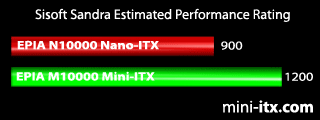
Sandra can quickly estimate a performance rating for a system, based on various factors such as CPU speed, RAM size etc. The rating of 900 puts the board at 75% of the speed of the M10000, but as we discovered later - this was not entirely indicative of real world use. However it's certainly not going to win any awards for folding - today's most powerful CPUs can achieve 10 times this figure.
CPU Benchmark
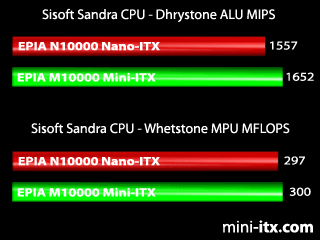
The Dhrystone benchmark is a long standing industry benchmark used to measure CPU performance using a standardised sample of mainly numerical operations. The result is given in MIPS (Million Instructions Per Second). The N10000 produced approximately 1.5 MIPS per 1 MHz of CPU speed - about 93% the speed of our M10000 yardstick.
The Whetstone benchmark measures FPU (Floating Point) performance, although many modern processors have a number of newer features such as out-of-order execution, pipelining and SSE2 which are not tested using this benchmark. We're traveling at 99% of our M10000 with this one.
CPU Multi-Media Benchmark
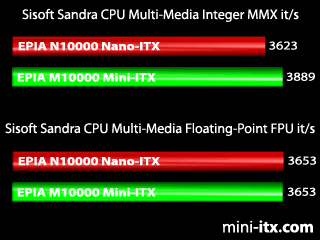
The CPU Multi-Media Benchmark uses all the Multimedia Extensions available to the CPU to draw a Mandelbrot fractal. Multimedia Extensions are additions to the x86 instruction set designed to make repeated or parallel operations run faster. Digital imaging or streaming video applications can make good use of these extensions, which use Single Instruction Multiple Data (SIMD) techniques. Changing the contrast of an image or MPEG decoding and encoding all require a large amount of data to be manipulated by the same instructions. This benchmark is therefore a reasonably good test of raw and MPEG2 recording and playback functionality. The N10000 achieved 3623 here, approximately 93% of the M10000.
The Floating-Point results were identical to the M10000 at 3653, unsurprising given the earlier Whetstone performance. Real world results will depend on the particular SIMD instructions used by a particular task.
Memory Benchmark
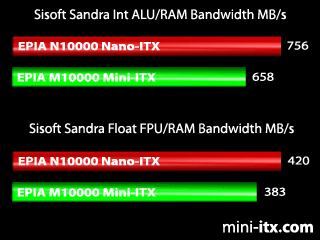
Sandra's Memory Benchmark creates several large arrays in memory and performs simple memory-bound arithmetic computations on them - thus reading and writing memory broadly independent of the CPU. It is slightly more objective than simply reading and writing to a large block of memory. The results of 756 Integer and 420 FPU were both significantly faster than the M10000, as you would expect when testing a 400MHz SODIMM against a 266Mhz DIMM. The SODIMM used in the N10000 runs faster than the DDR DIMMs used in the M board.
Rip WAV to MP3
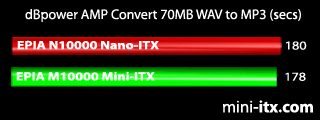
Next we used dBpower AMP Music Converter to convert a 70MB WAV file to an MP3, using the default settings. We've still got the same file from all our previous tests, so have a direct comparison. By ripping from the hard disc and not a CD, we removed the CD from the test and concentrated more on the raw power of the CPU. A similar task would be compiling a Linux kernel. Our file was converted in 3 minutes, exactly the same as the M10000 achieved when it was on the bench. A modern Intel or AMD CPU will of course do the same test in under a minute.
Benchmarks (2) - AES Encryption -->
*Advert* World's Smallest 12V DC-DC ATX
Power Supply now at the Mini-ITX store! *Advert*
The picoPSU is now available at the Mini-ITX.com Online Store. We serve the UK, Europe, USA and beyond. Order in-stock components before 7.00PM GMT and we'll ship same day! |
|
|
|

